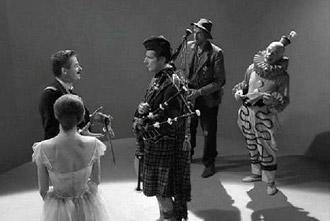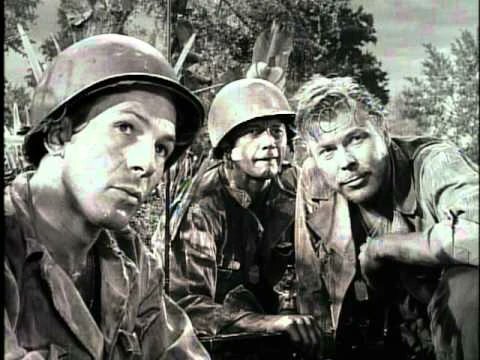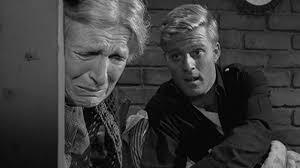September 5, 2024: The Twilight Zone rewatch continues with season 3, episodes 13-16!
Season 3, Episode 13, “Once Upon a Time”
This episode was first broadcast December 15, 1961.
The 1890’s street scenes were shot on MGM’s “Western Street”, last glimpsed in “A Stop at Willoughby”.
In the original script, the 1890’s scenes had dialogue and were shot like the contemporary scenes. After watching the first cut, however, it was decided to give those early scenes a silent film feel by removing the sound and dialogue, introducing music and card inserts, and losing the occasional frame in editing.
In the script’s first draft, Rollo and Mulligan spend much of the 1962 scenes running around a food market in search of a replacement t.v. tube. The sequence was dropped in favor of the much less dynamic repair shop scenes.
Richard Matheson apparently wrote this script especially for Keaton who he knew through mutual friends.
According to series producer Buck Houghton, Buster Keaton was “absolutely wonderful” to work with and helped refine many of the episode’s sight gags.
The old-fashioned clothes wringer Keaton uses to dry his pants in this episode was the same type of wringer that caught his finger when he was three-years-old, necessitating the amputation below the first knuckle.
In the episode’s final shot, the camera pans up towards the stars – and catches the top of the set.
This episode was directed by Norman Z. McLeod who was once one of Paramount’s top directors. His early films included The Marx Brothers’ Monkey Business (1931) and Horse Feathers (1932) as well as films starring W.C. Fields, Danny Kaye, Red Skelton, and Bob Hope. He was in semi-retirement when he was offered the opportunity to direct this episode. It would be his final gig.
Actor Buster Keaton, who played Woodrow Mulligan, got his start in a travelling vaudeville act with his parents, an act that often involved him being flung around the stage. Born Joseph Frank, he was nicknamed Buster by Harry Houdini who witnessed him fall down a flight of stairs at the age of three (apparently a bad year for him).
At the age of 21, he met comedian Fatty Arbuckle who helped kickstart his career, co-starring with him in some shorts before moving on to features and leaving his studio to Keaton. Keaton took advantage to produce his own films. When Arbuckle’s career took a downturn as a result of a scandal, Keaton stuck by his friend, offering him work after the rest of Hollywood turned their backs on him.
At the height of his popularity, Keaton was making two movies a year. Eventually, Keaton landed with MGM and that proved to be, in his own words, “the worst professional mistake” he had ever made. Reluctantly ceding creative control to a bunch of executives (who always know better) his career promptly tanked. He was fired by MGM, became an alcoholic, divorced, and lost it all. He remarried and eventually made a quiet comeback, but he never attained the lofty heights he’d achieved early in his career. A life-long smoker, he was apparently diagnosed with lung cancer after inquiring about a months-long cough but the doctors, fearing he wouldn’t be able to handle the truth, simply didn’t tell him. So Keaton, assuming he was simply fighting off a bad case of bronchitis, remained active, unaware of his terminal diagnosis. He died in his sleep after playing cards with his wife one night.
Stannley Adams, who played Rollo, was an actor and screenwriter known for his portrayals of millionaire Rusty Trawler in Breakfast at Tiffany’s (1961), Cyrano Jones on Star Trek (1966), and a sentient space carrot named Tybo on Lost in Space (1965). He took his own life after battling depression following a back injury that effectively ended his career.
Jesse White, who played the owner of the Fix-It Shop, is best known for his portrayal of the long-suffering Maytag repairman, a role he played from 1968 to 1989.
This is another one of those episodes that I love conceptually but feel it ultimately doesn’t come together. You all know how I feel about the “funny” episodes. Add the slapstick hijinks and it all just feels kind of embarrassing, probably even for the early 60’s. There were a few physical bits that I thought worked (ie Mulligan hiding behind the heavy-set Rollo) and I enjoyed the performances (I thought Adams was especially great), but this one just failed to impress in the end.
Season 3, Episode 14, “Five Characters in Search of an Exit”
This episode was first broadcast December 22, 1961.
This episode was based on a 4 page story pitch submitted to the production by Marvin Petal. He actually wrote an accompanying script but was informed that they were only buying the idea and Rod Serling would be writing the script. According to Petal: “I was paid only $250 and no residuals. As many times as that episode has been rerun on television, I regret not getting any residuals.”
The original title of the story was “The Depository” but it was changed because, apparently, the production felt it sounded too much like “suppository”.
Also, according to Petal: “The vertical climb was a challenge for them, but I suggested they build half of the huge container and make it horizontal and that is how they shot it. I wasn’t on the set when they filmed it, but they took my suggestion and went with it.”
The outdoor set for the final scene is the same spot on MGMs Brownstone Street where Dick York lands a coin on its side in “A Penny for Your Thoughts”.
This episode is said to be a partial inspiration for the movie Cube (1997).
Producer Buck Houghton’s daughter, Mona, appears at the end of this episode as the little girl.
Director Lamont Johnson, who directed “Five Characters in Search of an Exit”, would years later be enlisted by JJ Abrams to direct an episode of Felicity (1998), “Help for the Lovelorn”, that drew direct inspiration from this episode.
Actress Susan Harrison, who played The Ballerina, was the mother of Darva Conger, the contestant who “won” Who Wants to Marry a Multi-Millionaire (2000), married the schlub, and then found it strange when this relative stranger started making the moves on their wedding night.
William Windom, who played The Major, made his mark on stage and television, doing over a hundred guest spots on various shows. He co-starred alongside Inger Stevens (“The Hitch-Hiker”) in The Farmer’s Daughter (1963) and then starred in his own series, My World and Welcome to It (1969), in which he played a cartoonist with a vivid imagination. He was a series regular on Murder She Wrote (1984), playing the part of Dr. Seth Hazlitt for many years. He was also Commodore Decker on the Star Trek franchise and the voice of Uncle Chuck on Sonic the Hedgehog (1993).
Murray Matheson, who played The Clown, had his early stage work interrupted by WWII. After serving, he moved to Canada where he built a solid television career. Some of his more notable roles included KAOS mastermind Cedric Devonshire on Get Smart (1965), the alien Dr. Reynard on The Invaders (1967), and Felix Mulholland, the owner of Mulholland’s Rare Books & Prints, on Banacek (1972). His final role was in Twilight Zone: The Movie’s “Kick the Can” segment.
Clark Allen, who played The Bagpiper, co-owned the El Cid flamenco club in Los Angeles for almost twenty years with his wife. In 1972, he was shot there during an armed robbery but managed to make a miraculous recovery.
Kelton Garwood, who played The Tramp, found the onscreen opportunities so few and far between that, while doing a 12 episode run on Gunsmoke (1961), he also ended up taking a job at the Van Nuys Post Office.
Harrison (The Ballerina) and Windom, (The Major) battled it out for top billing in this episode but, if you ask me, their comparatively bland performances didn’t hold a candle to Murray Matheson as The Clown. Matheson delivers what is one of my favorite all-time guest spots on this show. And, as I was watching his animated delivery, I couldn’t help but be reminded of someone. I couldn’t think who until halfway through the episode when I realized…The Joker frrom the 1966 Batman series. I have no doubt that Caeser Romero based his performance, at least in part, on Matheson’s Clown.
This is one episode I did remember watching, mainly because as a kid, I absolutely loved the idea of this scenario playing out amongst my Planet of the Apes and superhero action figures. And yet, despite the passage of time, I still love “Five Characters in Search of an Exit” as much as I did when I first watched it at age 13. Definitely Top 10 material.
Season 3, Episode 15, “A Quality of Mercy”
This episode was first broadcast December 29, 1961.
This epiosde was based on a story idea by Sam Rolfe, co-creator of Have Gun Will Travel and The Man from U.N.C.L.E. He had wanted to write the script but was unable to do so, presumably due to time constraints. He later wrote a first draft of a script called “The Calculator” for The Twilight Zone, but it was never produced.
The jungle set was shot on the old Hal Roach Studios.
This was one of four episodes remade for Twilight Zone: The Movie (1983).
Actor Dean Stockwell, who played Lt. Katell, was the son of Broadway performers and an accomplished singer. He got his start in show business as a child actor, winning a Golden Globe in the category of Best Juvenile Performer. He dropped out of the business in the 60’s to join the Hippie scene, then returned in the 70’s. Times were lean and , in the 80’s, he had to work as a real estate broker to make ends meet. But he soon found success in moves like Paris, Texas (1984), Blue Velvet (1986), and Married to the Mob (1988) for which he received an Oscar nomination. In 1989, he landed the part of Al Calavicci on Quantum Leap, a role which earned him a Golden Globe.
Stockwell, apparently, auditioned for the role of Michael Corleone in The Godfather (1972), ultimatley losing out to Al Pacino.
He was originally cast to star in season 1’s “The Purple Testament” but had to bow out due to scheduling conflicts. Two years later, he landed a role in this episode, playing yet another hallucinating American soldier serving in the Pacific during WWII..
Albert Salmi, who played Sgt. Causarano, was last seen as Joe Caswell in season 1’s “Execution”.
Leonard Nimoy, who played Hansen, is best known as Mr. Spock from Star Trek, a role that earned him three Emmy nominations.
He came up with the idea for the Vulcan nerve pinch when the show’s writers were trying to think of a way for his character to overcome an adversary through non-violent means. Both he and William Shatner suffered from tinnitus, the result of a special effects explosion that went off too close to them during the filming of the episode “Arena”.
Nimoy’s final tweet, posted four days before his death, was “A life is like a garden. Perfect moments can be had, but not preserved, except in memory. LLAP” (Live Long and Prosper).
It’s clear that Serling, who also served in the Pacific during WWII, had staunch anti-war views and, every so often, they would come through in his writing. Unfortunately, they often did so in the form of clunky, heavy-handed messaging. As is the case in this episode. The “Japanese” make-up was silly enough, but requiring Stockwell to adopt a Japanese accent made it all even more painful to watch, especially considering the Japanese characters were already speaking English (!). I have no idea how the 1988 Twilight Zone movie reimainged this episode, but I hope it was with a little more subtlety in its execution.
In the end, one of the weaker episodes of this third season.
Season 3, Episode 16, “Nothing in the Dark”
This episode was first broadcast January 5, 1962.
This episode was originally intended to be the season 2 finale, but that honor ended up going to “The Obsolete Man” and “Nothing in the Dark” was moved into season 3 to give the production a strong head start on the season.
Director Lamont Johnson reflected back on Robert Redford’s audition with Gladys Cooper : “He [Redford] said he really wanted to meet her, so he came back and they read together, and I could see the lovely light of lechery in her eyes as she looked at him, because he was a very attractive young man. And he was delightful in it…so a nice chemistry developed in the reading. So I said “Thank you, Mr. Redford, we’ll let you know.” And he walked out the door, and the minute the door was closed, she reached over and said “Dahling, get him for me.” Like a tigress about to pounce.”
Actress Gladys Cooper, who played Wanda Dunn in this episode, started off as a child model before making her debut on the London stage in 1906. She was a star of silent film as well as a popular pin-up girl during WWI. In 1917, she started co-managing The Playhouse Theatre, something unheard of for a woman at the time. Then, in 1927, she took over full control and managed it herself for the next six years. She made numerous guest appearances on television and enjoyed a 30 year film career. In 1967, she was honored as a Dame Commander of the Order of British Empire (DBE) for her great accomplishments in furthering acting.
Robert Redford, who played handsome Mr. Death, was a bit of a rascal growing up, stealing hubcaps in high school and losing a college baseball scholarship because due to drunkeness. He decided to study art after high school and took a trip through Europe that convinced him he wasn’t particularly talented and should consider an alternate career path. He chose acting.
At the age of 33, he landed his breakthrough role as Sundance in Butch Cassidy and the Sundance Kid (1969), following that up with The Way We Were (1973) and The Sting (1973), which made him No. 1 at the box office for the next three years. His directorial debut, Ordinary People (1980), won him the Academy Award for Best Director in 1981.
Redford had this to say about his Twilight Zone experience: “I recall how everyone from the director to the actors to the designers had everything ready frrom the moment we began filming. It was so laid out that by the time we finished the last scene, it felt like a few hours passed by. Gladys Coper was a wonderful woman to work with, and a pro all the way. That was a good script too. Of course, no one ever thought then that (the episode) would become a classic and shown around the world like it is today. I don’t prefer to look back at my earliest efforts but I have to admit, to this day, I am proud of that one.”
R.G. Armstrong, who played the contractor, would appear in over 80 films and guest on 90 t.v. shows over the course of his long career. He died 24 days after the death of his best friend, Andy Griffith.
Gladys Cooper delivers a wonderfully poignant performance in this episode while Redford does a fine job of looking very handsome. “Nothing in the Dark” is regarded highly by many Twilight Zone aficionados but I found this another case of “great idea, lacklustre execution”. I did really like how our faux cop bounced back from being shot after a nice cup of tea though!
The post September 5, 2024: The Twilight Zone rewatch continues with season 3, episodes 13-16! appeared first on Joseph Mallozzi's Weblog.
Joseph Mallozzi's Blog
- Joseph Mallozzi's profile
- 39 followers







